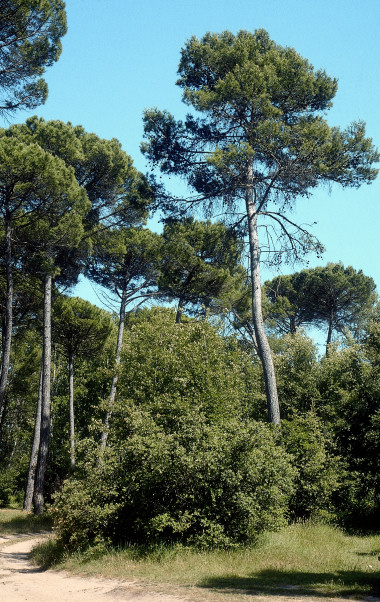Aleppo pine forest
Singular places
, Siles
Bucentaina
This appealing forest track runs through an Aleppo pine with a dense undergrowth of oaks, strawberry trees and laurustinus. Just as you come in sight of the village of Puentehonda, you can see two huge venerable Aleppo pines right next to the track. They are included in the Inventory of Unique Andalusian Trees under the names of Barrancos de Puentehonda Pine and Cerro Bucentaina Pine, respectively. The latter stands 32 m tall and measures 4.5 m in diameter at the base.
Aleppo pines (Pinus halepensis) are the most characteristically Mediterranean pine. Their common name in Spanish (durillo) indicates the hardiness of a tree that colonises rocky outcrops, arid land and rocky slopes in full sunlight where no other tree could grow. They cover a sizeable portion of the Nature Reserve, from the lowest valleys up to an altitude of 1600 m, thanks to their ability to withstand periods of draught (they can survive on less than 300 mm of rainfall a year) and to colonize dry areas with poor soil. Aleppo and Corsican pines are the preferred trees for reforestation in the Reserve’s mountains. Wherever there is arid land, there is a tree that will withstand it: our Aleppo pines.
Normally, this forest is composed of a stratum of bushes that is characteristic of the seral stages of Mediterranean forests, generally at the initial stage, although there a stratum of bushes can also be found in the more advanced stages of plant succession. Thus, Aleppo pines grow along with rosemary (Rosmarinus officinalis), lentiscos (Pistacia lentiscus), teberinths (Pistacia terebinthus), broom (Genista scorpius), sage-leaved rock roses (Cistus salviifolius), juniper (Juniperus oxicedrus), thyme rock roses (Fumana thymifolia), asparagus (Asparragus acutifolius). There are also a number of aromatic plants, including marjoram (Thymus mastichina) and thyme (Thymus orospedanus, Thymus zigis ). However, esparto grass (Stipa tenacissima) is the species that is almost always present in Aleppo pine forests.
LOCATION
The itinerary starts at the Peña del Olivar Recreational Area, on the road from Siles to Las Acebeas, and it is signposted as PR-A 175. It is a narrow forest track just under 5 km long, very suitable for walking. The first kilometre is a bit of a climb but the rest is almost flat.




